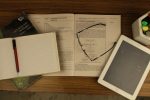At first, going paperless sounds like a hard concept to adjust to as a college student. Most of us are used to buying notebooks year after year just to barely use them for actual note-taking. I know I’m not the only one who’s ever bought a notebook for a class, just for a professor to give printouts of their slides or have fill-in the blank notes. Or have you gotten to the end of the semester only to realize that you bought notebooks for five classes and only ended up using two?
Going paperless is definitely a huge investment upfront. You would need an iPad with an Apple pencil or some sort of tablet with a stylus. I know that can get expensive, but it pays off in the long run, when you no longer have to buy notebooks year after year. There are several reasons to go paperless as a college student, but here are the seven reasons why I decided to make the transition.
Just a disclaimer, I am not 100% paperless quite yet. I still own a paper planner, but everything else is done on my iPad. I do plan to eventually make the transition to being 100% paperless but for now I’ll stick to my paper planners.
1. Help Save the Environment
As we all know, our environment is slowly deteriorating due to pollution and industrialization. Going paperless is one way to help save the environment as it reduces the amount of waste you put out there.
Going paperless helps to cut down on rapid deforestation and pollution. Which, in turn, leaves more trees to help take the excess carbon dioxide out of the atmosphere. If you care anything about helping to preserve the Earth, consider going paperless to significantly cut down on the amount of waste you put out there.
2. Easy, Stress Free Organization
Have you ever forgotten your notebook for a specific class? We’ve all been there at some point or another. When that happens, you end up pulling out a notebook designated for another class just to take notes, which can be annoying and disrupt your organization.
By going paperless, you never have to worry about forgetting a notebook for class. Everything can be found it one place. Most note-taking apps allow for users to create different notebooks or folders for classes, which helps to improve organization. Also, with digital note-taking, you have the freedom to rearrange your notes as you see fit.
3. Easily Customizable Notes
My favorite part about transitioning to paperless has been the ability to easily customize notes. Using diagrams and pictures helps me to learn and process information better, so being able to easily add those into my notes during class has been amazing.
Besides being able to add visuals to my notes, the customization is endless. Sometimes the notes given in lectures aren’t organized in a way that’s optimal for you. By going paperless, you can reorganize your notes however you please.
You can also easily switch colors or go back and change the colors of certain elements. Normally in lectures, I will write my notes in one solid color and then go back afterwards and change my headings to a different color, which helps to break up the information a little bit.
4. Able to Share Notes Across Platforms
We’ve all been in the predicament where a friend or classmate has asked to use our notes to study for an upcoming test. Well, with digital note-taking, it is easier to email or share your notes with friends and classmates without having to entrust them with the only physical copy of your notes.
Since all your notes are in one place digitally, it is easier than ever to find the topics they need notes for and share only those. And, you still have study material as well because let’s face it, how many times have you let a friend borrow your notes and they lose them?
Aside from sharing notes with your classmates, it is also easier to share your notes across your own devices. For example, if you like to study from physical paper notes, you can always print notes out from your laptop and use those to study from.
5. A Note-taking App for Everyone
Everyone’s note-taking style is different and personal to them. One of the hardest parts of transitioning to paperless is finding a note-taking app that works best for you. Not all note-taking apps are free, and it can seriously suck to waste money on an app you hate.
There are a multitude of note-taking apps out there to try, but I’ll suggest three that I have personally tried. During the beginning stages of my transition I used OneNote, which was a free app available through Microsoft. The pros to OneNote was that you can create a notebook for each semester and create smaller subsections for each class. The con was that there was not any page separation. Everything was just one continuous scroll.
I have also tried Notability and GoodNotes as well. Unlike OneNote, these apps are not free, but in my opinion, they are definitely worth the price and have better features to offer. My personal favorite is GoodNotes because it is set up just like a regular notebook and there are endless customization opportunities. Notability is also good; I just favored the set up and style of GoodNotes more.
I would recommend Notability to students who like to record lectures because that is a feature specific to the app. There are many more note-taking apps, but before you decide on one, hit up YouTube for reviews.
6. Lighten Your Load
Carrying a heavy backpack all across campus can be both exhausting and annoying. By ditching the notebooks and going paperless, you instantly can lighten your load and free up space in your backpack.
I rarely carry a textbook to class unless I physically use it in the classroom, so notebooks were taking up a lot of real estate in my backpack. Going paperless has been the best thing ever. Now I bring my laptop, iPad, planner and my file folder to class. Those are the only four things consistently in my backpack.
7. Access Your Notes Anytime, Anywhere
Having access to your notes anytime or anywhere is definitely a huge pro to going paperless. You don’t have to worry about digging through piles of paper looking for your notes and chances are, you will always have your laptop or tablet on you.
Going paperless has saved me so many times, when I have been stuck at the airport on the way back from Thanksgiving or spring break. It’s allowed me to easily study on planes and on road trips without making a mess.
Being 100% paperless is honestly impossible because you can’t expect your professors to adjust to you, so you are going to have some paper. I normally carry a file folder for any handouts given to me by professors, just to keep those in one place. But going paperless on your end definitely will have a positive impact on the environment.
The transition can be difficult, but once you get the hang of it, going paperless is worth it. If you need more advice on going paperless, head on over to YouTube; there are several student-run channels that talk about how they transitioned to paperless and their pros and cons. Watching YouTube helped me fully make the transition to paperless.
















